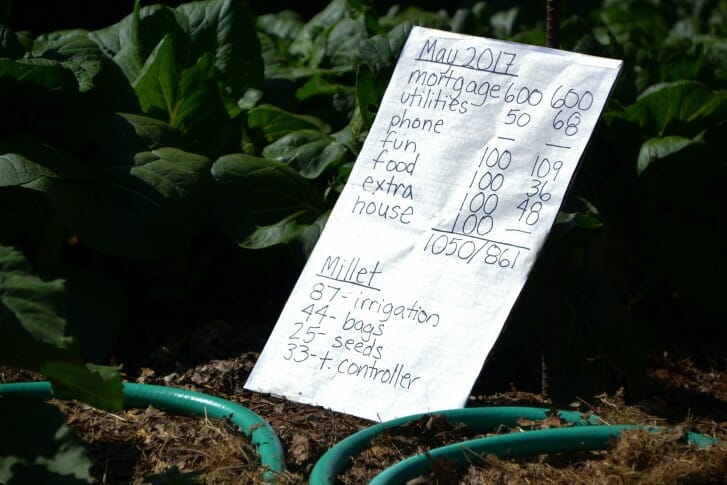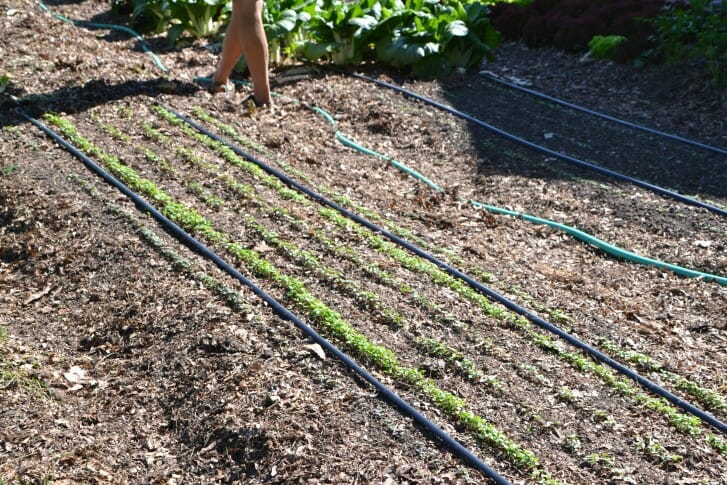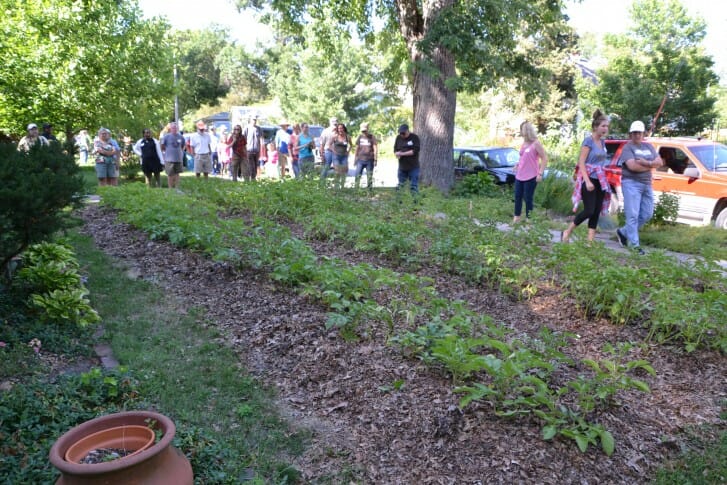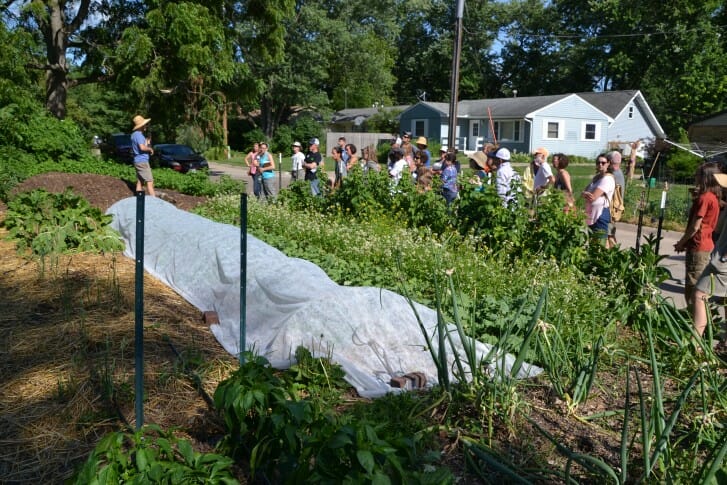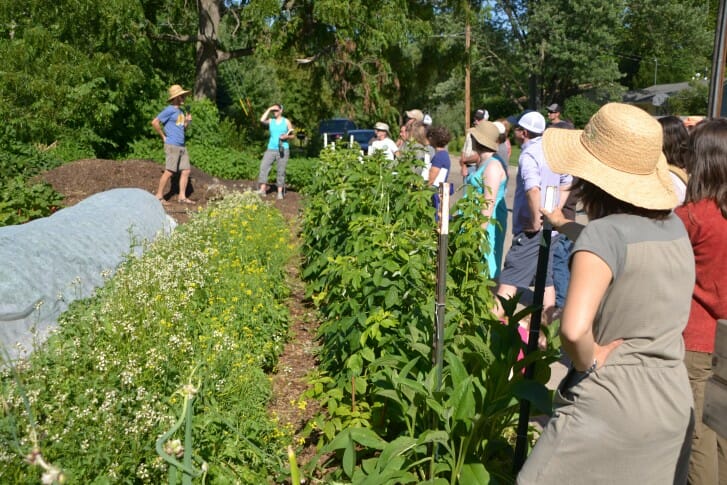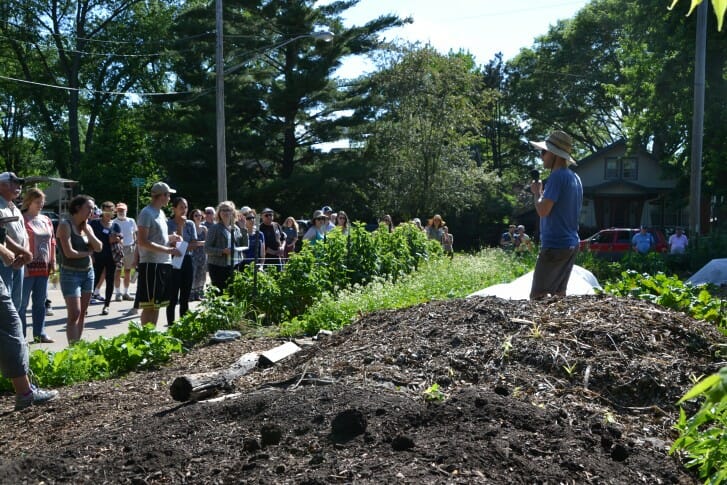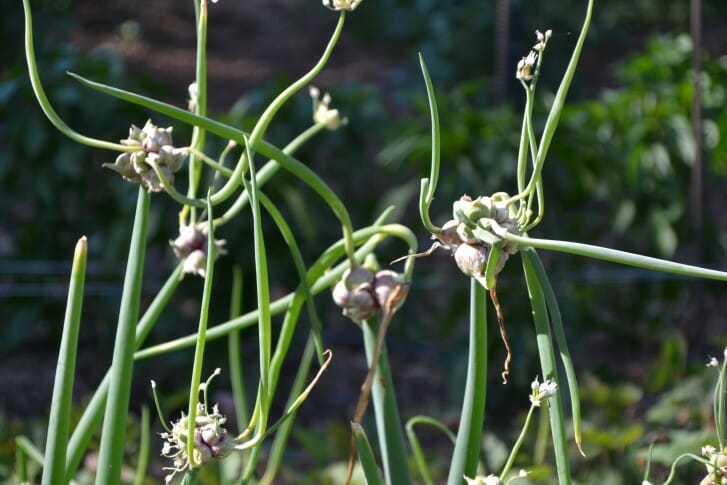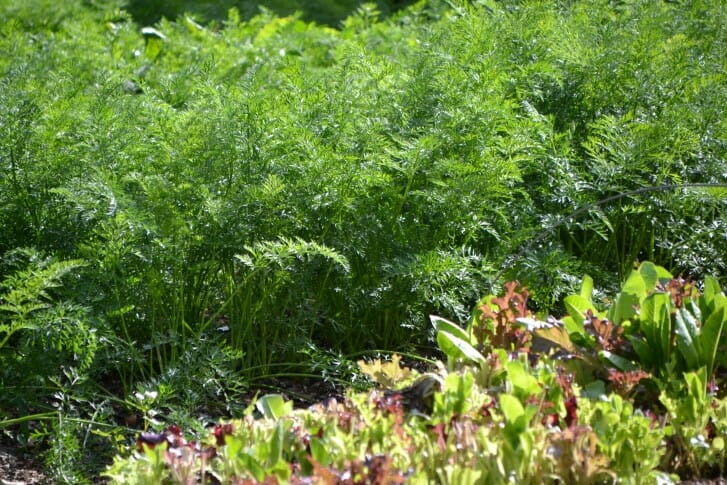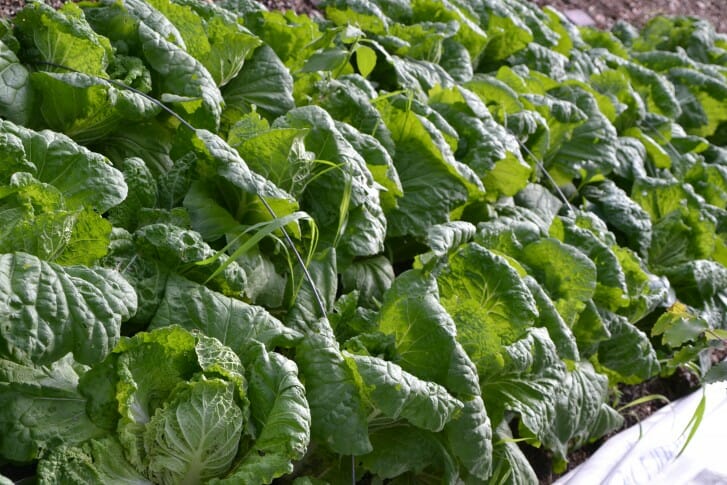Field Day Recap: Urban Farming at The Millet Seed Farm
The Millet Seed Farm is located in Iowa City, on six plots that total about 1/5 of an acre. Jon runs a 30-week, 20-member CSA, most of whom live in the neighborhood. “The mission of Millet Seed Farm is to grow healthy food for ourselves and our local community using sustainable farming practices, and to provide a model for small-scale farms to pop up in cities that are primarily human powered,” says Jon.
“I had been saving money to buy land just outside of Iowa City, and it just became clear after awhile that it would hard to find people – including myself – that wanted to commit to that type of investment. We were also struggling with the zoning issues. I was already gardening the corner lot by my parents when this house came up for sale. We decided to get the house, even if only temporary, and used some of the money saved for farmland as a down-payment. Since then Wren and I have been developing the gardens in the front and backyards. Early on we grew only food for ourselves. In 2012 I took a break from farming at Echollective Farm to work on homesteading skills, especially building.”
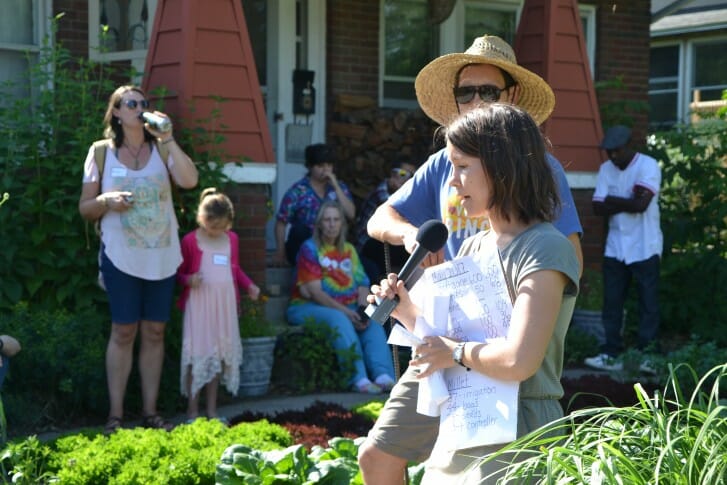
Wren Almitra, Jon’s partner, clarifies some points on the household budget. Wren is also involved in agriculture, as the Women, Land and Legacy Coordinator at the Women Food and Ag Network (WFAN).
Farm Financials and Budgeting
“Our goal on our farm is that the farm allows me to earn a modest income so I don’t need to get an off-farm job.”
Keys that make our farm possible:
1. Low living expenses
2. Low farm expenses
3. Available markets
4. Past farming experience growing food for a market
“CSA makes sense for us because we already want to grow a diversity of food for ourselves, and I just needed to scale up to do the CSA. We also have a lot of support in this community, so CSA made sense. Another benefit of the CSA is that the members get to experience the farm in their community – they pickup in our backyard. For me, trying to market throughout the season while growing food is a huge challenge, so I like only having to marketing at the beginning of the year.”
“The CSA size was based on what my living expenses are. I track my monthly expenses, and I’ve been doing it long enough that I can pretty much tell you how much I spend on my categories every month. I keep a little sheet of graph paper in my wallet and hold up the line every time I buy something to write it down. I identify my farm expenses by an “M”. I like doing this because I can easily see what my needs are and where I can reduce expenses that aren’t needs. I set a budget for each month, and try to over-budget a little. If I go under that I’m able to save money, and right now I’m usually under $1,050/mo. I think it’s important to choose to spend money on the things you value, like local and organic, but choose not to spend money on goods that are prone to exploiting others.”
“All the beds are 25′ long and 4′ wide, on average. Though some of the beds are my feet instead of an actual foot. For joi choi, I can get 72 plants in half a bed, in 4 rows, 8 inches apart. This allows me to get three harvests from the bed, they’re smaller during the first harvest and then they continue size up really well. By the third harvest they’re about 3lbs/head, the first harvest is 1/2 lb to 1lb. The joi choi is very heat tolerant; some of the other bok choi will bolt in the heat, but I’ve had very few problems with the joi choi.”
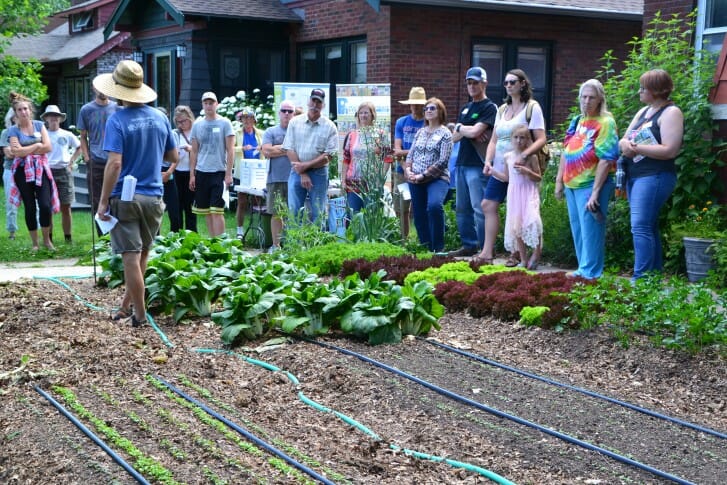
Joi choi next to Jon.
“In the past I’ve mixed all spicy mix together, but now I do individual varieties, because they bolt at different times. I plant the ones that are most likely to bolt between those that are less likely to bolt. When I clear out the row of bolting varieties, there is more space for the others to fill in and I can still get a second or third cutting. The spicy mix I use is: red Russian kale, arugula, mizuna, tat soi, red giant mustard, and some southern giant mustard. The arugula and mizuna bolt quickly, so they go between the red Russian kale and mustards.”
One of Jon’s concerns is keeping the drip tape from “crinkling” in the heat. When the drip tape gets hot in the sun, it can scald young greens if it touches them.
Breaking into Sod
“We use potatoes to break the ground on sod. Tarp weeding makes it easier to get out the roots on sod, but this time we just put leaves on, thick enough to kill the sod, and use potatoes as a first crop. This year we dug a little trench for the potatoes to go into, but in the past I’ve literally put them on the grass and they grow up through the leaves. You won’t get an amazing potato crop doing that, but it will still kill the sod. I’ve also used a walk-behind BCS to break sod, but unless I was doing a really big area, I’d stick with mulching heavy and doing a pioneer crop of potatoes. Squash would also be a fantastic pioneer crop. Anything that’s spaced far apart, has a long season, and you can mulch heavy will work. I did sheet mulching with cardboard once, and it was a wet year – I really paid the price for it. The soil was water-logged the whole season and I had disease pressure. Leaves from the city are partially shredded with their vacuum, so I don’t need to process them any further. It’s hard to work with leaves that aren’t partially shredded.”
“I’m not super-impressed with this potato crop. It’s been a little dry, and I don’t think I put enough mulch down after we took the tarp off. We’re also experimenting with shade-grown potatoes under this maple tree (the maple tree will be removed). I only use leaf mulch, which the city delivers for free. If I had to buy all the much I was using, I’d probably spend $1,000 on straw mulch, which would be 30% of my current budget. After these potatoes, I’ll either put a cover crop on in August, or put in a late fall greens crop. When I harvest the potatoes, I’ll pull away the un-decomposed mulch and store it in the pathways. That will allow me to pretty much have weed-free beds that I can seed directly into. Last year we put in daikon radish and that worked great. This bed may be problematic because of tree roots; I’ll be interested to see how it works.”
Neighborhood Pests
“Cucumbers and zucchini are under the row cover to protect them from insects; I’ll take the cover off as soon as it flowers. A lot of this was cover cropped – you can see some straw leftover. I tried to do a mow-kill, and I had a pretty good kill-rate but not 100%. On my scale it’s fine to pull the remainder, but on a large-scale it might be problematic.”
“Our rabbit pressure is low because we have so many cats in the neighborhood, but I do protect my sweet potatoes with row cover. Cats are a blessing and a curse – they kill rabbits but they do like to use my beds as a litter box and they’ll scratch up new plantings. I also use row-cover to protect from cats, but sometimes they just scratch through. Squirrels are probably my biggest nemesis. I wish I could have squirrel stew every night. In the spring they come through digging for nuts – they aren’t meaning to mess up my beds but they cause a lot of problems.”
Comfrey
“If I could do it all over again, I’m not sure if I would plant comfrey. It works great on the border, but I think it would be nice to have something a little more diverse to attract pollinators and predatory insects. The idea was for the comfrey to act as a nutrient accumulator, because their deep roots draw up minerals that otherwise aren’t available to the garden plants. I mow it down and compost it to harvest the nutrients to use in the beds. Be careful in small spaces – it doesn’t spread by seed, but it will come up from the roots in new places and spread its diameter significantly. I let it grow about waist high, then cut it and throw it into the paths, the beds or the compost pile. This summer I’ve cut it twice, already. ”
Soil Fertility
“Leaves, compost, and composted rabbit manure are my primary sources of fertility. I buy compost from the city for $20/ton – we also make our own), and the rabbit manure is from a friend. The city compost has a high carbon content because of how many sticks are in it, so I’d like to get away from using that, or put it in the paths for a year and let it mellow, then rake it into the beds. I hope to do a lot of fertility building in the paths, then push it into the beds to keep them raised. They were built raised, but over time they do sink down. I’ve found a broadfork is a little too bulky, if I need to do a little aeration I now prefer to use a pitchfork. The soil at this location is very different than the soil in our yard.”
“My favorite thing to grow right now are Egyptian walking onions. I’m still learning how to best propagate them and use them in my markets. I’m experimenting with scaping, like with garlic, in hopes to send more energy back to the bulb.” Jon is also experimenting with ginger.
Crop Rotation
“I have tried to figure out how to do a 7-year rotation, but now I’m just trying not to grow the same thing in the same place two years in a row. But people are saying that in the no-till system, with good soil biology, you can get away with not rotating as much. I have enough disease pressure on certain things that I do want to continue to rotate, but I think as long as we’re treating the soil well and not till, that we’re headed in the right direction.” Below, Jon stands between a crop of walking onions and an elderberry bush, behind him. In some shady areas he is experimenting with elderberry, paw paw, ramps, and Solomon seal.
Example Crop Planning for CSA
“Based on experience, for carrots, I decide how many weeks of carrots I want to give (15 weeks of a 30-week season). Then I determine how many row-feet of carrots per member are needed (~2 ft), and make my calculation from there. With 6 rows per bed, I need four of my standard beds to have enough carrots for the CSA. I don’t have time to leave any of my beds open. When I seed carrots, I water them well, cover them with burlap and then leaves so I don’t need to water them again – just check them to pull off the burlap before they germinate. In the mean-time I’ve started some beets… if I have a bad stand of carrots I’ll interplant the beets into the carrots, if it’s a good stand of carrots I’ll plant the beets somewhere else. This has worked well.”
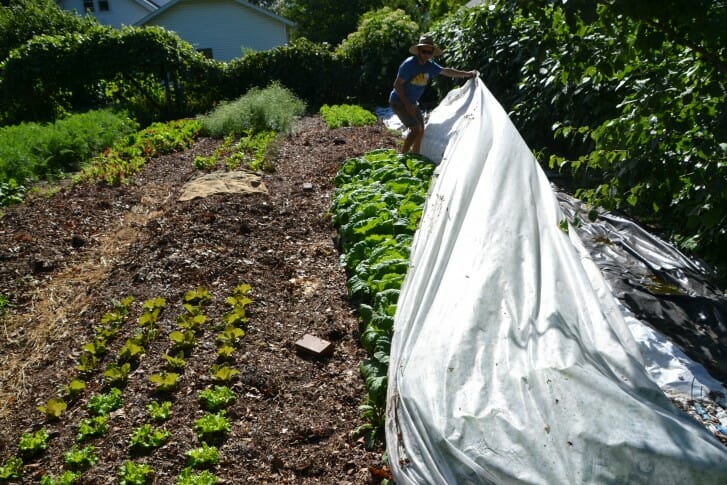
Jon uses Ag-19 for most row covers (Ag-30 for season extension), but might experiment with insect or bird netting.
Jon is experimenting with different heat-tolerant head lettuces, including Muir, Magenta, and Coastal Star.
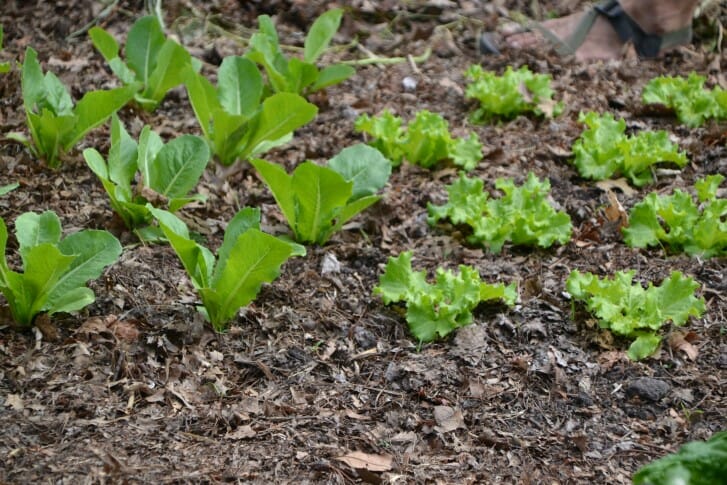
“I transplant everything except the spicy greens mix, carrots, and parsnips, and corn and beans, at some other plots. I even transplant beets and cilantro. I use WINSTRIP flats, which are very durable and do air-pruning. I’ll put 10-20 cilantro seeds in each cell and leave them for about 10 days. I plant them out about 8″ apart, and I can do 72 bunches of cilantro. In the spring and fall I can get cut-and-come-again, but in the summer they bolt quickly. This would be hard on a large scale, but on this small scale the transplanting is pretty manageable. Transplanting saves a lot of field time – about a month of crop production time.”
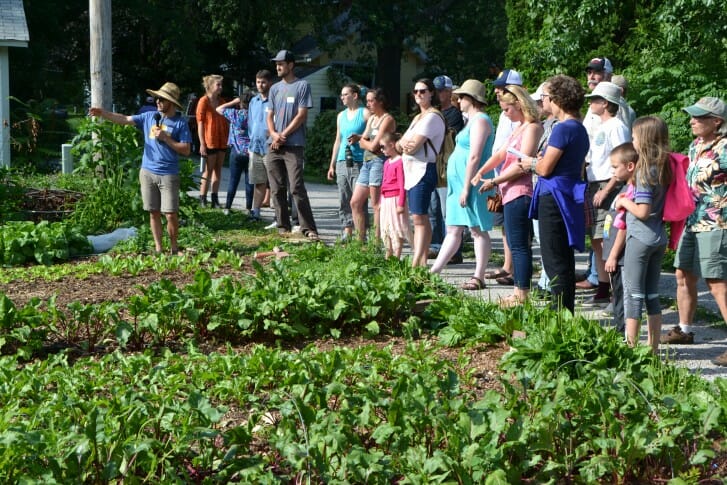
Beets, below, are transplanted.
Jon plants napa cabbage 8″ apart in four rows (in a 30″ bed). The first harvest thins them and provides a substantial head; by the second harvest the remaining heads are about 3lb. “My insect problems in Napa cabbage are earwigs and millipedes. Row cover is the only thing I use for insects; if I was to use an insecticide it would be an organic-approved product, but I really prefer not to use any. I think we have enough diversity that I can get away with occasionally losing something to insects. I do struggle with dampening off, especially with carrots.”
Jon has elderberry on the edges of several plots, and also forages for elderberry and other fruits, and mushrooms. Foraged crops and home-fermented food, like kimchi and saurkraut, are part of their CSA. Elderberry can fruit on one-year wood, but Jon is still experimenting with the best way to manage them. Jon harvests the umbels and put them in the freezer immediately, stem and all. “You don’t have to leave them in there for long, but the freezing really helps the stem come off easily. If you don’t do that and you have a difficult variety, it can take a long time to get the stems off.” For more on elderberry production and processing, check out these resources (here, here, here) from the 2017 PFI Annual Conference.
The field day ended with a delicious spread of food, including locally-made bread (Local Crumb) and dosas (Katy Hoffer), locally-made cheese (made by Laura Shorey with milk from Hansen’s Dairy), and farm-grown, -made, and -fermented: black bean hummus (Grimm Family Farm black beans), cilantro pesto, kimchi, and saurkraut.
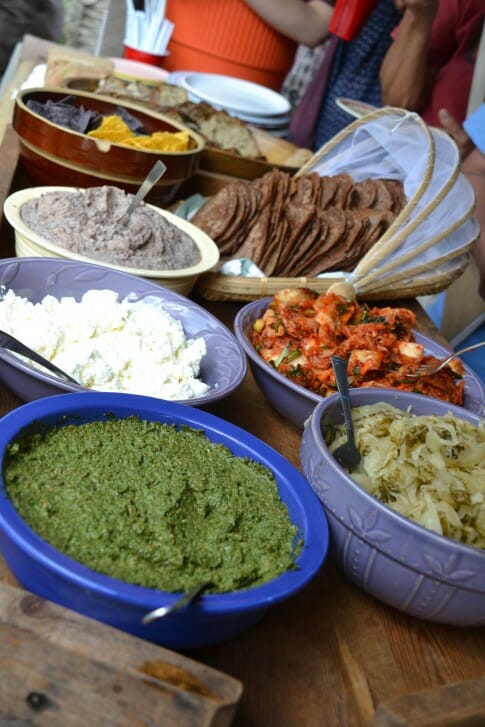
Thanks to Iowa Farmers Union for providing additional support for this field day.

